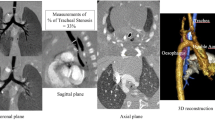Abstract
Background
Tracheal trifurcation is an uncommon and often unknown type of anomalous tracheobronchial arborization, characterized by three main bronchi originating at the level of the carina. Diagnosis is important due to its clinical implications.
Objective
To highlight the anatomical, clinical and diagnostic aspects of tracheal trifurcation by reporting our experience and reviewing the literature.
Materials and methods
We retrospectively evaluated pediatric patients referred to our institution from January 2018 to May 2020 with a diagnosis of tracheal trifurcation. All patients underwent chest radiographs, computed tomography (CT) (with/without dynamic airway scanning) and bronchoscopy. Clinical and anatomical data were collected.
Results
Three patients with tracheal trifurcation were identified (1 female, median age: 7.6±0.4 months). All had associated anomalies: two had tetralogy of Fallot, one with esophageal atresia/tracheoesophageal fistula and one with an atrioventricular septal defect, and the other had skeletal ciliopathy. Chest radiographs were not diagnostic for tracheal trifurcation. Bronchoscopy could not fully evaluate the trachea and main bronchi in two cases. CT detected tracheal trifurcation in all of the patients and also demonstrated other lung parenchymal and congenital anomalies. Two of the three main bronchi were directed to the right lung in all cases. Ostial stenosis of either the central (two patients) or right upper bronchus (one patient) was present. No signs of tracheobronchomalacia were found.
Conclusion
Tracheal trifurcation is rare and often associated with additional disorders, such as other tracheobronchial anomalies, cardiovascular defects or esophageal malformations, responsible for clinical manifestations and earlier detection. Bronchoscopy is often used for diagnosis, but is invasive and may be incomplete or inconclusive, while CT allows for a noninvasive and correct diagnosis, while also highlighting additional findings in the thorax.




Similar content being viewed by others
References
Sundarakumar DK, Bhalla AS, Sharma R et al (2011) Multidetector computed tomography imaging of congenital anomalies of major airways: a pictorial essay. World J Radiol 3:289–297
Cristallo Lacalamita M, Fau S, Bornand A et al (2018) Tracheal agenesis: optimization of computed tomography diagnosis by airway ventilation. Pediatr Radiol 48:427–432
Ghaye B, Szapiro D, Fanchamps JM, Dondelinger RF (2001) Congenital bronchial abnormalities revisited. Radiographics 21:105–119
Song X, Lu Z, Zhu L et al (2020) Morphologic analysis of congenital heart disease with anomalous tracheobronchial arborization. Ann Thorac Surg 110:1387–1395
Speggiorin S, Torre M, Roebuck DJ et al (2012) A new morphologic classification of congenital tracheobronchial stenosis. Ann Thorac Surg 93:958–961
Woodring JH, Howard TA, Kanga JF (1994) Congenital pulmonary venolobar syndrome revisited. Radiographics 14:349–369
Ruchonnet-Metrailler I, Abou Taam R, de Blic J (2015) Presence of tracheal bronchus in children undergoing flexible bronchoscopy. Respir Med 109:846–850
Schwartz IE, Utz ER, Gaudreau PA (2018) Congenital complete absence of tracheal rings with trifurcate carina: case report of a rare clinical and endoscopic presentation. Int J Pediatr Otorhinolaryngol 111:1–6
Ullmann N, Secinaro A, Menchini L et al (2018) Dynamic expiratory CT: an effective non-invasive diagnostic exam for fragile children with suspected tracheo-bronchomalacia. Pediatr Pulmonol 53:73–80
Seymour FK, Roebuck DJ, McLaren CA, Bailey CM (2006) Congenital segmental absence of tracheal rings. Int J Pediatr Otorhinolaryngol Extra 1:45–49
Sarin YK (2010) Tracheal trifurcation associated with esophageal atresia. APSP J Case Rep 1:14
Torre M, Speggiorin S, Roebuck DJ et al (2012) Congenital absence of cartilaginous tracheal rings associated with esophageal atresia and trifurcated carina: a novel anomaly? J Pediatr Surg 47:1008–1011
Taghavi K, Perry D, Hamill JK (2014) Congenital trifurcation of the trachea. Eur J Pediatr Surg Rep 2:35–37
Wu E-T, Yang M-C, Wang C-C et al (2014) Congenital right intermediate bronchial stenosis with carina trifurcation: successful management with slide tracheobronchial plasty. Ann Thorac Surg 98:357–359
Nakazato Y, Wells TR, Landing BH (1986) Abnormal tracheal innervation in patients with esophageal atresia and tracheoesophageal fistula: study of the intrinsic tracheal nerve plexuses by a microdissection technique. J Pediatr Surg 21:838–844
Chassagnon G, Lefort B, Meot M et al (2017) Association between tetralogy of Fallot and tracheobronchial branching abnormalities: a new clue for pathogenesis? J Am Heart Assoc 7:e006921
Wineland AM, Thomsen JR, Landry A et al (2017) Segmental deficiency of cervical tracheal rings masquerading as complete tracheal rings: a case report and literature review. Int J Pediatr Otorhinolaryngol 101:246–248
Konen E, Katz M, Rozenman J et al (1998) Virtual bronchoscopy in children: early clinical experience. AJR Am J Roentgenol 171:1699–1702
Erdem SB, Yozgat Y, Karkıner A et al (2015) Carinal trifurcation associated with isolated partial anomalous pulmonary venous return. Turk Gogus Kalp Dama 23:544–548
de Lagausie P, Van Den Abbeele T, Elmaleh M et al (2001) Bronchial trifurcation in a congenital pulmonary venolobar syndrome. Pediatr Pulmonol 31:303–305
Heyer CM, Nuesslein TG, Jung D et al (2007) Tracheobronchial anomalies and stenoses: detection with low-dose multidetector CT with virtual tracheobronchoscopy--comparison with flexible tracheobronchoscopy. Radiology 242:542–549
Acknowledgements
We thank Dr. Luca Borro for the drawings in Fig. 1.
Author information
Authors and Affiliations
Corresponding author
Ethics declarations
Conflicts of interest
None
Additional information
Publisher’s note
Springer Nature remains neutral with regard to jurisdictional claims in published maps and institutional affiliations.
Rights and permissions
About this article
Cite this article
Santangelo, T.P., Ottavianelli, A., Curione, D. et al. Tracheal trifurcation: new cases and review of the literature. Pediatr Radiol 51, 1848–1855 (2021). https://doi.org/10.1007/s00247-021-05075-y
Received:
Revised:
Accepted:
Published:
Issue Date:
DOI: https://doi.org/10.1007/s00247-021-05075-y




